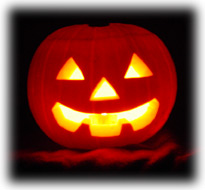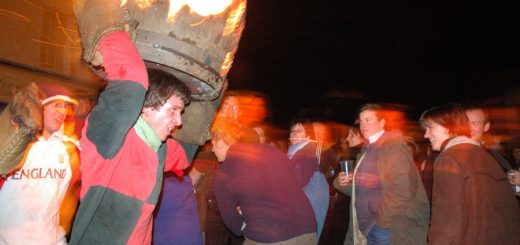Beltane
Beltane (or Beltaine) is a festival that marks the return of summer with the lighting of fires; where people could burn their winter bedding and floor coverings, ready to be replaced afresh. Referred to as a Gaelic ceremony, it has been celebrated for thousands of years throughout the United Kingdom and Europe. In fact in Ireland, it supposedly marks the arrival of the Gaels on to Irish shores.
 Also referred to as Roodmas, Rood day, the Eve of St Walburga’s Day and Walpugis Nacht (these last two show relations with St Walburga, who was born in Sussex and died in AD180 after emigrating to Germany. Walburg is also an old Teutonic name for the Earth Mother), this date also marks the festivals of Hades or Pluto, God of the Underworld.
Also referred to as Roodmas, Rood day, the Eve of St Walburga’s Day and Walpugis Nacht (these last two show relations with St Walburga, who was born in Sussex and died in AD180 after emigrating to Germany. Walburg is also an old Teutonic name for the Earth Mother), this date also marks the festivals of Hades or Pluto, God of the Underworld.
Early accounts of Beltane celebrations have been passed down by Julius Caesar, whose description of the Scottish Celts celebrations of the festival must be seen as biased.
Supposedly, animal sacrifices would be made each Beltane to ensure the fertility of their crops, however, every five years the Highland Celts would sacrifice humans, the numbers being made up of convicted criminals and prisoners of war. They would be sacrificed by the Druids, though the manner of their death would vary. Many were supposedly shot with arrows, but descriptions of Gaulish Celt ceremonies have them being burnt alive in huge wicker men.
While their is little evidence to suggest the use of the wicker man, many Iron Age ‘bog bodies’ have been found preserved in peat in the British Isles and Northern Europe. These show signs of having been ritually murdered in a variety of ways (strangulation, blows to the head, throat cutting and a combination of each). While this does not suggest they were sacrificed on Beltane, it does give a glimpse into the savage part of ancient religion.
Fires were lit on hilltops at Beltane as late as the 1700s, and Beltane is still a major ceremonial date in the Wiccan and Pagan year, although these don’t include sacrifices.
Later accounts of Beltane festivities refer to a Beltane Cake, baked with eggs. A special piece of this referred to as the Beltane Carline spelt symbolic doom to whoever was unlucky enough to receive it. Once identified, the person with the Beltane Carline would be set upon by some of the others who would attempt to throw them on the fire. This would be prevented by the rest of the festivalgoers. The unlucky person would then be considered a symbolic sacrifice and referred as being dead for the rest of the evening.
SOURCES:
Golden Bough – Frazer
What Witches Do – Stewart Farrar
Celtic gods and Goddesses – R J Stewart.




Re: Beltane
‘Lancashire Folk-lore’ (1867) by John Harland and T. T. Wilkinson.
BEAL-TINE OR BELTANE FIRES; RELICS OF BAAL WORSHIP.
Among the dim traces of an extinct worship of Bel, or Baal, the ancient sun-god, perceptible still among Celtic peoples, especially in Ireland and Scotland, are the three festival periods when fires are kindled on eminences in honour of the sun. The Bel, or Belus, the chief deity of the Babylonians and the Assyrians, seems to have been identical with theBaal of the Phœnicians and Carthaginians. The Chaldee Bel and the Hebrew Baal alike mean "Lord;" and under these names worship was paid by the old Asiatics to the sun, whose light and heat-giving properties were typified by fires kindled on the tops of high hills. In parts of Lancashire, especially in the Fylde, these traces of a heathen cult still linger. "From the great heaps of stones on eminences, called Cairns, from the Toot-hills (i.e., the hills dedicated to the worship of the Celtic god, Tot, or Teut, or Teutates, the same with the Egyptian Thoth), and the Belenian eminences, whereon was worshipped Bel, or Belus, or Belenus, the sun-god; from these three kinds of heights the grand sacred fires of theBel-Tine flamed thrice a year, at three of the great festivals of the Druids, in honour of Beal, or the Sun—viz., on the eve of May-day, on Midsummer Eve, and on the eve of the 1st November. Two such fires were kindled by one another on May-day Eve in every village of the nation, as well throughout all Gaul as in Britain, Ireland, and the outlying lesser islands, between which fires the men and the beasts to be sacrificed were to pass; from whence came the proverb, ‘Between Bel’s two fires,’ meaning one in a great strait, not knowing how to extricate himself. One of the fires was on the cairn, and the other on the ground. On the eve of the 1st of November all the people, out of a religious persuasion instilled into them by the Druids, extinguished their fires. Then every master of a family was religiously obliged to take home a portion of the consecrated fire, and to kindle the fire anew in his house, which for the ensuing year was to be lucky and prosperous. Any man who had not paid all his last year’s dues to the Druids was neither to have a spark of this holy fire from the cairns, nor dared any of his neighbours let him take the benefit of theirs, under pain of excommunication; which, as managed by the Druids, was worse than death. If, therefore, he would live the winter out, he must pay the Druids’ dues by the last day of October. The Midsummer fires and sacrifices were to obtain a blessing on the fruits of the earth, now becoming ready for gathering; as those on the 1st of May, that they might prosperously grow; and those on the last of October were a thanksgiving for finishing their harvest. But in all of them regard was had to the several degrees of increase and decrease in the heat of the sun. At the cairn fires it was customary for the lord of the place, or his son, or some other person of distinction, to take the entrails of the sacrificed animal into his hands, and walking bare-foot over the coals thrice, after the flames had ceased, to carry them to the Druid, who waited in a whole skin at the altar. If the fire-treader escaped harmless, it was reckoned a good omen, and welcomed with loud acclamations; but if he received any hurt, it was deemed unlucky both to the community and to himself." In Ireland, May-day is called la na Beal tina, and its eve, neen na Beal tina—i.e., the day and eve of Beal’s fire, from its having been in heathen times consecrated to the god Beal, or Belus. The ceremony practised on May-day Eve, of making the cows leap over lighted straw or faggots, has been generally traced to the worship of this deity.
The Irish have ever been worshippers of fire and of Baal, and are so to this day. The chief festival in honour of the sun and fire is upon the 21st [24th] June, when the sun arrives at the summer solstice, or rather begins its retrograde motion. "At the house where I was entertained, in the summer of 1782, it was told me that we should see at midnight the most singular sight in Ireland, which was the lighting of fires in honour of the sun. Accordingly, exactly at midnight, the fires began to appear; and, going up to the leads of the house, which had a widely-extended view, I saw, on a radius of thirty miles all around, the fires burning on every eminence. I learned from undoubted authority that the people danced round the fires, and at the close went through these fires, and made their sons and daughters, together with their cattle, pass the fire; and the whole was conducted with religious solemnity." Bonfires are still made on Midsummer Eve in the northern parts of England and in Wales. The 1st of November was considered among the ancient Welsh as the conclusion of summer, and was celebrated with bonfires, accompanied with ceremonies suitable to these events, and some parts of Wales still retain these customs. Dr. Jamieson, in his Dictionary of the Scottish Language, mentions a festival called Beltane or Beltein, annually held in Scotland on Old May Day (May 13th). A town in Perthshire is calledTillee Beltein—i.e., the eminence or high place of the fire of Baal. Near it are two Druidical Temples of upright stones, with a well adjacent to one of them, still held in great veneration for its sanctity. The doctor describes the drawing of bits of a cake, one part of which is made perfectly black with charcoal, and he who draws the black bit is considered as "devoted to Baal, and is obliged to leap three times through the flame."
Pennant, in his Tour in Scotland, gives a like account, with other ceremonies. The custom existed in the Isle of Man on the eve of the 1st of May, of lighting two fires on a hill-top, in honour of the pagan god Baal, and of driving cattle between those fires, as an antidote against murrain or any pestilent distemper for the year following. It was also customary to light these fires on St. John’s Eve (June 23rd), and up to the present time a stranger is surprised to see on this day, as evening approaches, fires springing up in all directions around him, accompanied with the blowing of horns and other rejoicings. Macpherson notices the Beltein ceremonies in Ireland, and adds, "Beltein is also observed in Lancashire." On Horwich Moor are two heaps of stones, or cairns, which are called by the country people "The Wilder Lads." It is believed that on May Day Eve the Druids made prodigious fires on cairns, situated as these are, on lofty eminences, which being every one in sight of some other like fire, symbolized a universal celebration. These fires were in honour of Beal, or Bealan, latinized into Belenus, by which name the Gauls and their colonies denoted the sun; and to this time the first day of May is by the Irish called La Bealtine, or the Day of Belen’s Fire. It bears a like name among the Highlanders of Scotland, and in the Isle of Man.
The last evening in October was called the "Teanlay Night," or "The Fast of All Souls." At the close of that day, till of late years, the hills which encircle the Fylde shone brightly with many a bonfire; the mosses of Marton, &c., rivalling them with their fires, kindled for the avowed object of succouring their friends, whose souls were supposed to be detained in purgatory. A field near Poulton in which the mummery of the "Teanlay" was once celebrated (a circle of men standing with bundles of straw, raised on high with forks), is named "Purgatory" by the old inhabitants. Formerly this custom was not confined to one village or town of the Fylde district, but was generally practised as a sacred ceremony.